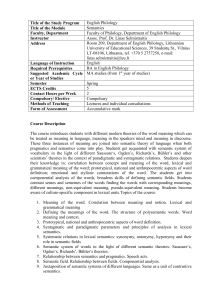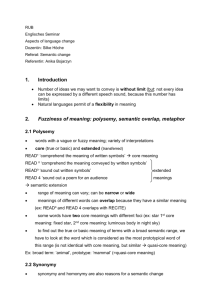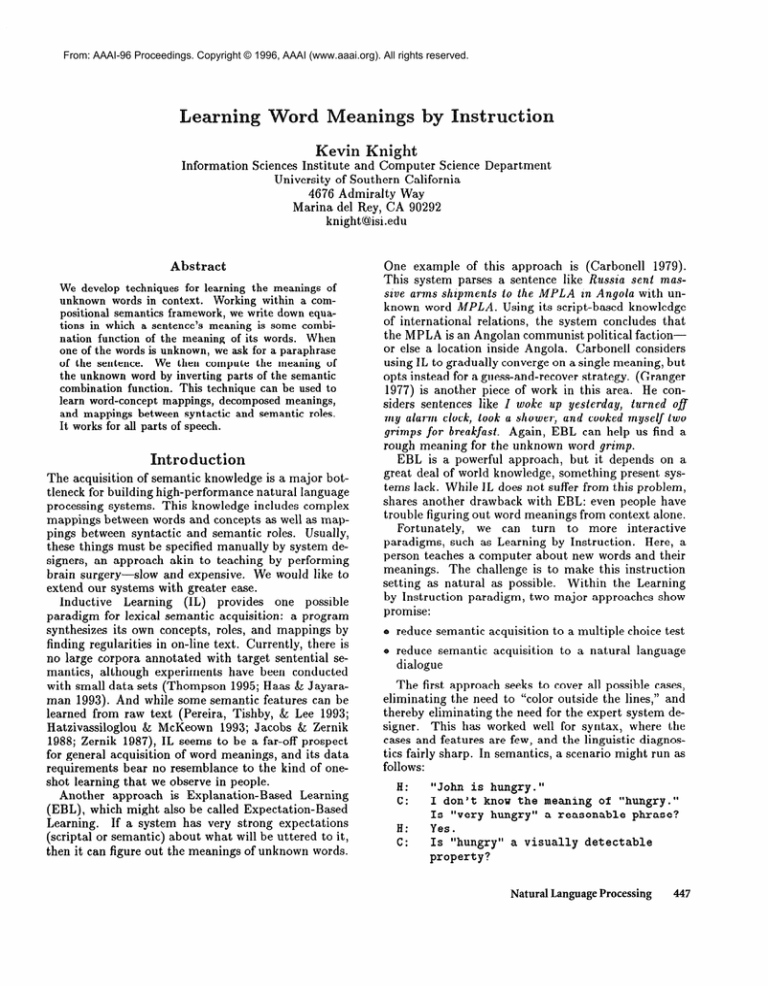
From: AAAI-96 Proceedings. Copyright © 1996, AAAI (www.aaai.org). All rights reserved.
earning
evin
night
Information Sciences Institute and Computer Science Department
University of Southern California
4676 Admiralty Way
Marina de1 Rey, CA 90292
knight@isi.edu
Abstract
We develop techniques for learning the meanings of
unknown words in context. Working within a compositional semantics framework, we write down equations in which a sentence’s
meaning is some combination function of the meaning of its words.
When
one of the words is unknown, we ask for a paraphrase
of the sentence.
We then compute
the meaning of
the unknown word by inverting parts of the semantic
combination
function.
This technique can be used to
learn word-concept
mappings,
decomposed
meanings,
and mappings between syntactic
and semantic
roles.
It works for all parts of speech.
Introduction
The acquisition of semantic knowledge is a major bottleneck for building high-performance natural language
processing systems. This knowledge includes complex
mappings between words and concepts as well as mappings between syntactic and semantic roles. Usually,
these things must be specified manually by system designers, an approach akin to teaching by performing
brain surgery-slow
and expensive. We would like to
extend our systems with greater ease.
Inductive Learning (IL) provides one possible
paradigm for lexical semantic acquisition: a program
synthesizes its own concepts, roles, and mappings by
finding regularities in on-line text. Currently, there is
no large corpora annotated with target sentential semantics, although experiments have been conducted
with small data sets (Thompson 1995; Haas & Jayaraman 1993). And while some semantic features can be
learned from raw text (Pereira, Tishby, & Lee 1993;
Hatzivassiloglou & McKeown 1993; Jacobs & Zernik
1988; Zernik 1987), IL seems to be a far-off prospect
for general acquisition of word meanings, and its data
requirements bear no resemblance to the kind of oneshot learning that we observe in people.
Another approach is Explanation-Based Learning
(EBL), which might also be called Expectation-Based
Learning. If a system has very strong expectations
(scriptal or semantic) about what will be uttered to it,
then it can figure out the meanings of unknown words.
One example of this approach is (Carbonell 1979).
This system parses a sentence like Russia sent massive arms shipments to the MPLA in Angola with unknown word MPLA. Using its script-based knowledge
of international relations, the system concludes that
the MPLA is an Angolan communist political factionor else a location inside Angola. Carbonell considers
using IL to gradually converge on a single meaning, but
opts instead for a guess-and-recover strategy. (Granger
1977) is another piece of work in this area. He considers sentences like I woke up yesterday, turned 08
my alarm clock, took a shower, and cooked myself two
grimps for breakfust. Again, EBL can help us find a
rough meaning for the unknown word grimp.
EBL is a powerful approach, but it depends on a
great deal of world knowledge, something present systems lack. While IL does not suffer from this problem,
shares another drawback with EBL: even people have
trouble figuring out word meanings from context alone.
Fortunately, we can turn to more interactive
paradigms, such as Learning by Instruction. Here, a
person teaches a computer about new words and their
meanings. The challenge is to make this instruction
setting as natural as possible. Within the Learning
by Instruction paradigm, two major approaches show
promise:
reduce semantic acquisition to a multiple choice test
o reduce semantic acquisition to a natural language
dialogue
The first approach seeks to cover all possible cases,
eliminating the need to “color outside the lines,” and
thereby eliminating the need for the expert system designer. This has worked well for syntax, where the
cases
and features
are few,
and
the linguistic
diagnos-
tics fairly sharp. In semantics, a scenario might run as
follows:
H:
c:
H:
c:
"John is hungry."
I don't know the meaning of "hungry."
Is "very hungry" a reasonable phrase?
Yes.
Is "hungry" a visually detectable
property?
Natural
LanguageProcessing 447
H:
c:
II:
c:
II:
c:
H:
c:
H:
No.
Does “hungry” refer to a capability
(or lack of one)?
No.
Does “hungry” refer to a desire?
hungry =
Yes.
Is it a desire to (a) do something,
(b) own something,
(c) be something,
(d) other?
(a).
A desire to do what?
To eat.
The system directs the acquisition with easily answerable questions, and builds semantic representations based on the user’s responses. In the scenario
above, multiple choice finally gives way to a freer-form
input, but with careful design, this type of interaction
can be limited. Note that the above scenario must be
continued for the acquisition of syntax/semantics mapping information (e.g., the noun syntactically modified
by hungry plays the role of agent in both the wanting
and the eating events).
A second approach, pursued in this paper, is to allow free-form natural language interaction. This is a
bootstrapping approach, in which the system uses its
current knowledge of language to gain more. Semantics gets a constant workout, as we try to mimic the
way people learn new words and mappings. Here is
such a scenario:
II:
c:
II:
c:
“John is hungry. ”
I don’t know the meaning of “hungry. ”
I mean: “John wants to eat .”
(I know the meanings of “John”,
“wants”,
“to”,
“eat”,
and “is”. . ,
let me figure
out what “hungry”
means...
okay, I’ve got it.>
The user has provided an interpretable paraphrase
of the uninterpretable sentence. The system computes
the meaning of the paraphrase, then deduces the meaning of the unknown word.
This sort of reasoning is similar to solving arithmetic equations.
We might fancifully suppose that
word meanings were numbers, and that the meaning
of a sentence were an arithmetic combination of the
meanings of its words. For example, John is hungry
might mean:
John + is. hungry2
(1)
and John wants to eat might mean:
John + 5 . wants
toeat
If the meaning of hunorw is unknown, and if we know
that (1) and (2)- are paraphrases
- of each other, we can
solve for the unknown meaning by cancelling John and
inverting the arithmetic functions:
I
IR & NLP
5 . wants
J is . toeat
Evaluating the right hand side of (3) yields a meaning for hungry.
Of course, meanings aren’t numbers and we don’t
take their square roots.
The rest of this paper is
concerned with algorithms for learning word meanings
within the framework of real computational semantics,
in which meanings are things like lambda-calculus expressions or graphs, combining via function application
or graph unification.
The technology we will develop has a number of applications. Learning meanings of new words is one.
Another is lexical decomposition.
We might first interpret hungry as a primitive one-place predicate. If
we break its meaning down, we reduce the number of
primitives, making it easier to specify semantic constraints and inference rules. Breaking down meanings
is also useful for capturing intensional constructs like
alleged murderer
(paraphrase:’ person who is said to
be a murderer,
not murderer with the property alleged).
Decomposition is critical for machine translation, where one language’s word is another’s lexical gap. For example, the Japanese verb seimai-suru
means to clean rice. We can build this meaning automatically if we are told that Yoko ga seimai-suru
means Yoio cleans rice. So paraphrases need not be
in the same language. Finally, as- a longer term goal,
we aim toward processing dictionary and glossary definitions for massive lexicon construction.
Semantic
Framework
This section lays out the framework for semantic interpretation that we will assume. The framework is
well known, simple, and concrete, allowing us to specify new algorithms in detail. It is also one that is used
in practical natural language systems like (Dowding et
al. 1993) and (Knight et al. 1995).
In the tradition of Montague (Dowty, Wall, & Peters
1981), we adopt a compositional semantics, in which
the meaning of a sentence is a function of the meanings
of its parts. Those parts are phrases and, ultimately,
words. So we need a database of word meanings and
a set of functions to combine word and phrase meanings. These functions can be specified declaratively
and applied with a handful of meta-operators.
The
lambda calculus is commonly used for representing semantic functions and data (Chierchia & McConnellGinet 1990). A flexible implementation popular in
computational circles is via graphs and graph unification. (Moore 1989) gives descriptions of these notational systems. We will assume that word meanings
and combination functions are all represented as labeled, directed acyclic graphs. We also assume that a
syntactic
analysis precedes semantic processing. Syntacticrules strongly restrict the ways in which we
might decide to combine meanings, and our semantic
combination functions are keyed to them. Such a function might say, if a constituent of type ADJ and a constituent of type N combine to form
a new constituent of
type NP, then the meaning of the NP is such-and-such
a function
of the meanings
of the N and the ADJ.’
We also assume that the semantic combination rules
themselves are fixed while we learn individual word
meanings. This assumption is reasonable, given the
no-longer-recent trends toward simplifying rules and
pushing complexity into the lexicon (Karttunen 1986;
Bresnan & Kaplan 1982).
Figure 1 shows formalized word meanings and combination functions for a sample sentence John wants
to eat.2
Graphs encode attributes and values, and
values may be atoms or (recursively) graphs themselves. There are two important top-level attributes.
The attribute sem encodes the core meaning-for
example, wants refers to a Wanting with an agent (agt)
and a wanted-thing (goal). The map attribute carries
syntax-semantics role mapping information. A path
through a graph corresponds to a role chain in knowledge representation languages. When two paths in a
graph converge, then the two role chains must have the
same value. In the cse of wants, sem agt (semantic
agent) is identified with map subj sem (semantics of
the yet-to-be determined subject of the verb).
Semantic interpretation proceeds as a bottom-up
traversal of the parse tree that assigns a meaning to
each node. Leaf node meanings are retrieved from a
dictionary of known words (from Figure 1). Assigning
meanings to internal nodes requires three operators:
unification (u), extraction (e), and subordination
(s):
e (u x y) - unify graphs x and y by combining information from both (Robinson 1965; Shieber 1986).
(e f x)
extract the subgraph of x beneath the
top-level arc labeled f.
e (s f x> create a new graph with a single arc
labeled f >pointing to graph x.
0
r Note that we assume a syntactic
parse is computable
even if the sentence contains a semantically
unknown word;
learning both lexical syntax and lexical semantics simultaneously is a topic for future investigation.
2Tl,e linguistic
structures
in Figure 1 implement
one
simple account of the syntax/semantics
of the sample sentences. There are other analyses. In particular,
our method
of discharging
verb-argument
features is not the best; see
Also note that
(Pollard & Sag 1994) for another treatment.
we handle the subject-control
facts of the verb wants during
semantic interpretation;
however, our role-filling takes the
key syntactic
processes into account.
For example, our lexical entry for wants might have directly identified the agent
of Wanting
with the agent of the goal of Wanting
(i.e.,
subject
sem agt = sem goal agt), eschewing complicated
But
role mapping (i.e., map inf map subj = map subj).
this would not generalize to sentences like John wants to be
seen, where it is apparent that syntactic subjects should be
unified, not semantic agents. This point will come up again
when we consider the options that face a learning program.
A meaning is assigned to each internal node as follows: (1) retrieve a semantic combination function (a
graph) based on the syntactic categories of the node
and its parse-tree children, (2) create a new graph for
each nth parse-tree child by subordinating its previously computed meaning graph to feature xn, (3) unify
all of the graphs from these two steps, and (4) extract
the x0 subgraph of the result. This is repeated for each
node in the tree.
Figure 2 traces the semantic interpretation of the
sample sentence. The meaning of John wants to eat is:
(e x0 (u R4
(u (s xl JOHN)
(s x2 (e x0 (u R2
(u (s xl WANTS)
(s x2 (e x0 (u Rl
(u (s xl TO)
(s x2 EAT)]
which evaluates to the graph
corner of the figure.
Solving
(4)
shown at the top left
for Unknowns
Interpretation goes smoothly when everything is
known. But our premise is that one word is semantically unknown, in the sentence John is hungry. Even
though hungry is not yet in the dictionary, we know by
the rules of semantic combination that the meaning of
John is hungry is computed by:
(e x0 (u R4
(u (s xl JOHN)
(s x2 (e x0 (u R3
(u (s xl IS)
(s x2 HUNGRY)]
(5)
We want to solve for the unknown word meaning,
given that the expressions (4) and (5) are equal. That
is, we want to write an equation like:
HUNGRY
= ( . .. ( . .. IS . . EAT . ..) . . . WANTS
TO )
with the ellipses filled in.
Our basic approach is to invert the operators that
combine semantic data (i.e., rules and word meanings),
just as we would invert arithmetic operators when solving arithmetic equations. There are only three operators to worry about: u, e, and s. The subordination
operator s inverts easily. (s-inv
f x) is just (e f
x). Unfortunately, (e-inv
f x) is multi-valued. It is
the set of all z such that (e f z) = x, and each z may
contain different information under arcs other than f.
Likewise for (u x ~1.~
Rather than invert each operator, we will invert an
idiom repeatedly used for semantic combination. We
define a new operator (n f x y):
(n f x y> = (2
I (e x0 (u x (s f 2)))
= y)
Here, x is a semantic rule unified with all known
constituents, f is the feature under which the unknown
constituent goes, and y is the desired result. With this
inversion operator n, we can write:
30ur arithmetic analogy in Section 1 also had this problem, as square
roots
may be either
positive
or negative.
NaturalLanguage Processing
449
r
(N +
(INF+TO
Rl
(V -3
“John”)
V)
R2
“wants”)
(VP +
V IN!=)
(TO +
R3
(V +
“to”)
(VP --+V
ADJ)
“eat”)
R4
(S +
NP VP)
Figure 1: Word meanings and semantic combination rules.
HUNGRY
=
(n x2 (u R3 (s xl IS))
(n x2 (u R4 (s xl JOHN))
(e x0 (u R4
(u (s xl JOHN)
(s x2 (e x0 (II R2
(u (s xl WANTS)
(s x2 (e x0 (u Rl
(u (s xl TO)
(s x2 EAT)]
The depth of the unknown word in the parse tree determines the number of embedded calls to n. We now
give an algorithm for computing (n f x y):
3. Prune the merged graph. The merged graph generally contains too much information. Many prunings are possible, so this step returns multiple values,
called pruned graphs. To prune, consider all subsets
of arcs in the merged graph, including the empty
set.4 For each subset, form a new graph h by deleting the arcs in that set from the merged graph. If h
satisfies (e x0 (u x (s f h)))
= y, then keep it;
otherwise throw it out. (Note: pruning is a generalization operation.)
4. Return the set of pruned graphs, removing duplicates.
Algorithm
1. Compute (e f (u x (s x0 y)) ). Call this the raw
graph. It forms the basis of the information to be
contributed by the as-yet-unknown constituent, but
it is not necessarily a subsumer or subsumee of the
final product.
Because calls to (n f x y) are nested, the value of y
may be a set. In that case, we repeat the above algorithm for each element of y, combining all the results.
2. Repeatedly merge the pairs of nodes in the raw
graph satisfying the following conditions:
We have implemented the above algorithm for ultimate
use in acquiring semantic information for a large-scale
machine translation system. This section shows results
for the example we have been following in this paper.
Solving for the meaning of hungry yields 5 possible solutions, shown in Figure 3. All of these graphs
“work” in the sense of achieving equivalent meanings
for John wants to eat and John is hungry, and the first
e the nodes have the same label (for leaf nodes).
o the nodes have identical arc sets (i.e., the same
labels and destinations).
e merging the nodes yields a graph h that maintains
(e
x0
(u x (s
f h)))
= y.
This merging proceeds bottom-up until no more
merges are possible.
Call the result the merged
graph.
450
(Note:
IR & NLP
merging
is a specialization
operation.)
Example
‘For efficie nt precessing, it is only necessary to consider
sets of individually pruneable arcs in the merged graph.
n
John
wants
to eat
wants
to eat
R2
(VP +v
INF,L
to
eat
John
wants
eat
Figure 2: Word meanings combine to form a sentence neaning in a compositional framework.
Natural Language Processing
451
graph is exactly what a human linguistic expert would
produce. Of the other four meanings generated by the
algorithm, one requires that the noun modified by hungry be a person- this would be reasonable if we used
different adjectives to describe hunger in different types
of entities. Less plausible is another meaning that restricts hungry to modify only things named John. Yet
another meaning for hungry dispenses with the modified noun altogether: X is hungry always means John
wants to eat.
To test the algorithm further, we can turn things
around and assume that hungry is known, but wants
is unknown. The case is interesting because the raw
graph is significantly different from our target meaning
(Figure 4). We write:
WANTS =
(n xl (u R2 (s x2 (e x0 (u Rl (u (s xl TO) (s x2 EAT))))))
(n x2 (u R4 (s xl JOHN)
(e x0 (u R4
(u (s xl JOHN)
(s x2 (e x0 (u R3
(u (s xl IS)
(s x2 HUNGRY)]
The algorithm generates 26 semantic candidates for
Many of these candidates include the direct
unification of (sem agt) with (sem goal agt), which
works for John wants to eat, but will fail for sentences
like John wants to be seen, where (sem agt) should
be unified with (sem goal patient),
via the identification of the two syntactic subjects.
wants.
Heuristics
We now have as many as 26 solutions to an equation
that is supposed to give us one lexical entry. Fortunately, there are a number of strategies for trimming
the solution set.
One idea is to preemptively narrow the set of candidates using heuristics- i.e., go beyond the data and
make an inductive leap. For example, for hungry, we
can throw out candidates that mention John or Person, under the assumption that this information was
This is heuristiccontributed by the word John.
the same piece of information may actually come from
several sources, as is commonly the case with agreement checking, e.g., (xi syn agr num) = (x2 syn
agr num). A second heuristic is to discard specific
pruned graphs in favor of more general ones, on the
principle that we want the most succinct graph that
does the job. 5 These heuristics narrow the solutions
for hungry from 5 to 1 and for wants from 26 to 3.
Figure 5 shows solution sets narrowed with these
heuristics, including an exact duplicate of the human expert’s entry for wants (cf. Figure l), as well
as some incorrect (though rather ingenious) structures
proposed by the algorithm.
5Note that these two heuristics have different effects.
For example, the “more specific” heuristic only rules out
three of the five learned graphs for hungry.
452
IR & NLP
A completely different strategy is to use inductioni.e., maintain multiple entries for a word in the lexicon,
and as the system encounters new sentences, jettison
entries that stop working.
iscussion
and Fbture Research
We have built an algorithm for learning the meanings
of unknown words in context. The algorithm is driven
by an interpretable paraphrase of the context, supplied
by the user. The algorithm is general with respect
to part of speech and can acquire word-concept mappings, lexical decompositions, and syntactic-semantic
role mappings.
Previous work in this vein includes (Reeker 1976;
Anderson 1977; Langley 1982). We have attempted
to strip away the assumptions and heuristics used
by these systems, and to provide a simple algorithm
suited to modern computational linguistic methods,
both practical and theoretical. More recent work by
(Thompson 1995) is also aimed at learning lexical semantics; it works by induction rather than instruction,
and it does not yet deal with case-role mappings. Combining inductive and instructive approaches to language learning is an open and potentially very interesting area of research. Other related work includes that
on unification-based generation (Shieber et al. 1989)
and on higher-order unification. Higher-order unification has been used to encode equations that provide
solutions to the interpretation of ellipsis (Dalrymple,
Shieber, & Periera 1991), and it would be useful to
explore how this relates to our inversion algorithm.
Formal analysis of complexity and completeness
would also be valuable. While much is known about
first-order unification of feature structures (Kasper
1987; Ait-Kaci 1984; Carpenter 1992), comparatively
little is known about its inverse. For example, one
simple problem is: Given 4 and $, compute all r satisfying 4 Ll r = $. For atomic unification (variable
symbol T, failure symbol I, and atoms al, ~2, . . .),
the answer is:
T
I
I
I
ai
ai
T
I
ai
T
ai
-l
{I,al,...,ai-1,Ui+1,...}
ai
ai
{T,
ai
ai
II
ai>
Tree unification, graph unification, and unification under equational theories are natural extensions to consider .
The problem addressed in this paper is a more complex variant: Given feature structures 4 and ti, and
Figure 3: Sample solutions for hungry produced automatically.
bi
raw graph
target graph
Figure 4: Raw graph and target graph for the meaning of wants.
n
hungry
wants
wants
wants
Figure 5: Sample solutions for hungry and wants narrowed heuristically.
Natural Language Processing
453
given feature label zi, compute all r satisfying:
understanding.
Proc. ARPA
In Human
Human
Language
Plainsboro, NJ: ARPA.
Dowty, D. R.; Wall, R.; and Peters, S. 1981. Introduction to Montague Semantics.
Dordrecht: Reidel.
QsLl[xi:T]=
There are also several directions in which to extend
this work for practical use. One is to learn syntactic
and semantic structures at the same time. Another is
to recognize when a known word should have its meaning extended. For example, hungry for bananas can be
paraphrased as wants to eat bananas. Given this new
hungry sentence, we want to add new role mapping information (for-PP maps to patient of the Eating, not
the Wanting) to the existing lexical entry for hungry.
Finally, we have assumed that the user-provided paraphrase is semantically unambiguous, but this will not
always be the case. The learning algorithm may be
able to reject some, but not all, of the paraphrase interpretations. The system will then need to interact
with the user to disambiguate the paraphrase. If this
interaction is to be natural, some ability to render different meanings unambiguously will be required.
Acknowledgments
Thanks to Ed Hovy and Yolanda Gil for comments on
a draft of this paper. This research was carried out
with funding from the Department of Defense.
References
Ait-Kaci,
H. 1984. A Lattice
Computation
Based
dered Type Structures.
Theoretic Approach to
on a Calculus of Partially Or-
Ph.D. Thesis, University of
Pennsylvania.
Anderson, J. R. 1977. Induction of augmented transition networks. Cognitive Science 1.
Bresnan, J., and Kaplan, R. 1982. Lexical-Functional
Grammar: a formal system for grammatical representation. In Bresnan, J., ed., The Mental Representation of Grammatical
Relations. MIT Press (Cambridge, MA).
Carbonell, J. 1979. Towards a self-extending parser.
In Proc. ACL.
Carpenter,
B. 1992. The Logic of Typed Feature
Structures,
volume 32 of Tracts in Theoretical Computer Science.
Cambridge: Cambridge University
Press.
Chierchia, G., and McConnell-Ginet,
Grammar:
An
Introduction
S. 1990.
Mean-
to Semantics.
The MIT Press.
Dalrymple, M.; Shieber, S.; and Periera, F. 1991.
Ellipsis and higher-order unification. Linguistics and
Philosophy 14(4).
Dowding, J.; Gawron, J.; Appelt, D.; Bear, J.;
Cherny, L.; Moore, R.; and Moran, D. 1993. Gemini: A natural language system for spoken-language
454
Granger, R. 1977. Foulup: A program that figures
out meanings of words from context. In Proc. IJCAI.
Haas, J., and Jayaraman, B. 1993. From contextfree to definite-clause grammars: A type-theoretic approach. Journal of Logic Programming
12(l).
Hatzivassiloglou, V., and McKeown, K. 1993. Towards the automatic identification of adjectival scales:
Clustering adjectives according to meaning. In Proc.
ACL.
Jacobs, P., and Zernik, U. 1988. Acquiring lexical
knowledge from text: A case study. In Proc. AAAI.
Karttunen, L. 1986. Radical lexicalism. Tech. Report
CSLI-86-68, Center for the Study of Language and
Information.
Kasper. 1987. Feature
with Application
IR & NLP
Structures:
A Logical Theory
to Language Analysis. Ph.D. Thesis,
University of Michigan.
Knight, K.; Chander, I.; Haines, M.; Hatzivassiloglou,
V.; Hovy, E.; Iida, M.; Luk, S. K.; Whitney, R.; and
Yamada, K. 1995. Filling knowledge gaps in a broadcoverage MT system. In Proc. IJCAI.
Langley, P. 1982. Language acquisition through error
recovery. Cognition and Brain Theory 5(3).
Moore, R. 1989. Unification-based semantic interpretation. In Proc. ACL.
Pereira, F. C. N.; Tishby, N. Z.; and Lee, L. 1993.
Distributional clustering of English words. In Proc.
ACL. Harriman, New York: Morgan Kaufman.
Pollard, C., and Sag, I. 1994. Head Driven Phrase
Structure Grammar.
University of Chicago Press.
Reeker, L. H. 1976. The computational study of language acquisition. Advances in Computers 15.
Robinson, J. A. 1965. A machine-oriented logic based
on the resolution principle. Journal of the ACM 12( 1).
Shieber, S. M.; van Noord, G.; Moore, R. C.; and
Pereira, F. C. N. 1989. A semantic-head-driven generation algorithm for unification based formalisms. In
Proc. ACL.
Shieber, S.
1986.
An Introduction
to Grammar.
to Unification-
University
Chicago. Also, CSLI Lecture Notes Series.
Based
ing and
Language
Technology:
Technology Workshop.
Approaches
of
Thompson, C. 1995. Acquisition of a lexicon from
semantic representations of sentences. In Proc. ACL,
Student
Session.
Zernik, U. 1987. Language acquisition:
hierarchy of phrases. In Proc. IJCAI.
Learning a

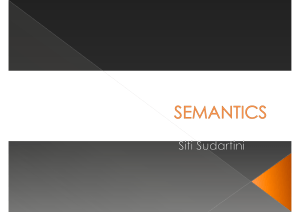

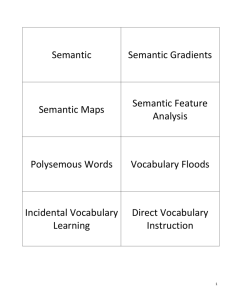

![Word Study [1 class hour]](http://s3.studylib.net/store/data/007905774_2-53b71d303720cf6608aea934a43e9f05-300x300.png)

